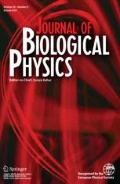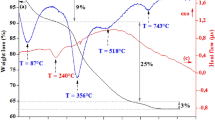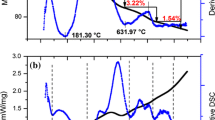Abstract
Thermal decomposition analysis of human femur bone has been carried out in the temperature range between 25°C and about 1000°C. In this temperature range, the differential primary weight loss curve yielded four distinct peaks for the femur bone. Each minimum inflexion point was arbitrarily chosen as the temperature at which the thermal decomposition of the component responsible for the peak had been completed. Aided by the thermogravimetric data on tendon collagen, the observed four peaks have been identified as follows: First: dissociation of water from the collagen; second: decomposition of collagen molecule itself; third: residual organic components associated with the collagen; fourth: water loss accompanied with the transformation of inorganic apatite and residual protein that were not decomposed at lower temperature. The fourth peak identified with the crystal transformation has been linked to the transformation ofα-tricalcium phosphate, which is known to have a hexagonal structure, toβ-tricalcium phosphate, which has a rhombohedral structure. This transformation has been observed between 700°C and 780°C which is in accord with the range observed in the transformation of synthetic apatite crystals. The experiments were performed under two different conditions: in normal pressure (in air) and in a reduced pressure of about 30μ Hg. In the average, the total weight loss up to the temperature of about 1000°C was about 35.64% for the heating in air and 36.45% for the heating in the reduced pressure. The weight loss has been carefully analyzed in the different temperature intervals and has been compared with an expected weight loss predicted by three most quoted formulas advanced for the apatite in bone. In addition to this, the conventional thermogravimetric analysis has been carried out in order to retrieve the thermal kinetic decomposition parameters corresponding to each peak. The activation energies corresponding to the first, second, and third peaks have been found to be slightly higher than those of tendon collagen. A detailed analysis showed that the bone contains about 28% protein and about 8% water (apatite crystalline water included).
Similar content being viewed by others
References
G. N. Ramachandran and G. Kartha,Nature,176 (1955) 595.
G. N. Ramachandran and V. Sasieskhran,Biochem. Biophys. Acta,109 (1964) 314.
A. Rich and F. H. C. Crick,J. Mol. Biol.,3. No. 3 (1961) 483.
L. C. Bonar and M. J. Glimcher,J. Ultrastructure Res.,32 (1970) 545.
E. Fukada and I. Yasuda,Prog. Polym. Phys. Japan,2 (1959) 101.
M. H. Shamos and L. S. Lavine,Nature,213 (1967) 267.
E. Fukada and I. Yasuda,Japan J. Appl. Phys.,3 (1964) 117.
J. J. Lim and M. H. Shamos,Biophys. J.,11 (1971) 648.
V. T. Tomaselli and M. H. Shamos,Biopolymers,12 (1973) 353.
A. Tanioka, E. Jojima, K. Miyasaka, and K. Ishikawa,J. Polym. Sci.,11 (1973) 1489.
E. Baer and R. Kohn,J. Macromol. Sci. Phys.,136 (1972) 761.
L. Winand, M. J. Dallemagne, and G. Duyckaerts,Nature,190 (1961) 164.
A. S. Posner,Calcification in Biological System, ed. by R. Sogmaes, A.A.A.S., Washington, D.C. (1960).
P. W. Arnold,Trans. Faraday Soc.,46 (1950) 1061.
P. Lerch and Vuillermier,Chimia,18 (1964) 391.
E. E. Berry,J. Inorg. Nucl. Chem.,29 (1967) 317.
W. F. Neuman and M. W. Neuman,The Chemical Dynamics of Bone Mineral, (University of Chicago Press, Chicago, 1958) p. 39.
R. E. Dehl and C. A. J. Hoeve,J. Chem. Phys.,50, No. 8 (1969) 3245.
J. J. Lim and M. H. Shamos,Biopolymers,13 (1974) 1791.
E. Fukada and I. Yasuda,J. Phys. Soc. Japan,12 (1957) 1158.
J. Freeman,Trans. N. Y. Acad. Sci.,29, Series II (1967) 623.
A. A. Marino, R. O. Becker, and C. H. Bachman,Phys. Med. Biol.,12 (1967) 367.
J. J. Lim and A. R. Liboff,J. Dent. Res.,51 (1972) 509.
J. Halager,J. Dent. Res.,69 (1970) 546.
E. S. Freeman and B. Carroll,J. Chem. Phys.,62 (1958) 394.
S. Brunauer, P. H. Emmett, and Teller,J. Am. Chem. Soc.,69 (1938) 309.
J. J. Lim, manuscript in preparation.
M. J. Dallemagne and L. J. Richelle,Biological Mineralization, ed. by I. Zipkin, (John Wiley & Sons, New York, 1973) p. 23.
A. S. Posner, C. Fabry, and M. J. Dallemagne,Biochem. Biophys. Acta,15 (1954) 304.
Author information
Authors and Affiliations
Rights and permissions
About this article
Cite this article
Lim, J.J. Thermogravimetric analysis of human femur bone. J Biol Phys 3, 111–129 (1975). https://doi.org/10.1007/BF02308895
Issue Date:
DOI: https://doi.org/10.1007/BF02308895




